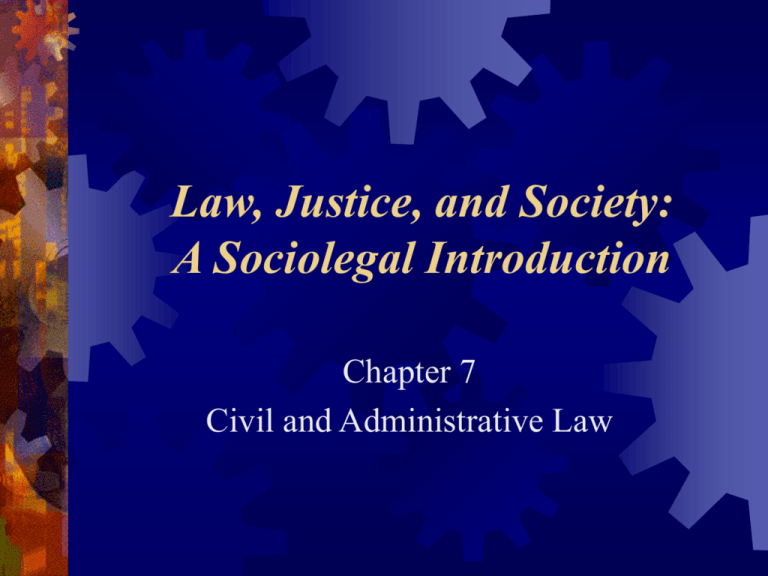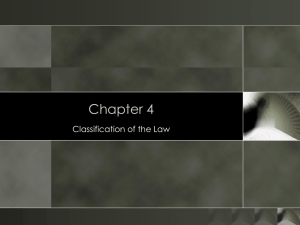Chapter 7
advertisement

Law, Justice, and Society: A Sociolegal Introduction Chapter 7 Civil and Administrative Law Civil and Administrative Law Civil law is private law in that it governs transactions between non-government entities such as corporations and private individuals Civil and Administrative Law Designed to provide remedies for individuals harmed by others To manage social conflict Restore social harmony (Myren 1988) Provides a means by which disputes between private parties can be resolved without the use of force Has its own substantive and procedural law, as well as precedent Civil and Administrative Law Complaint is filed by plaintiff Redress given in form of monetary damages (punitive damages) injunctions specific performance (particular actions the defendant must perform) Defendant may appeal verdict or judgment to higher court Civil and Administrative Law Burden of proof in civil trial: proof by a preponderance of the evidence evidence indicates that it is more likely than not that the defendant committed the wrongful act Also, clear and convincing evidence: punitive damages involuntary commitment Civil and Administrative Law Many rights provided in a criminal trial are not present in a civil trial: no exclusionary rule no right to remain silent diminished right to cross-examine hostile witnesses no legal obligation for the state to provide an attorney for indigent defendants Civil and Administrative Law Differences between Who is the legal victim? criminal and The state civil law The individual Who Initiates Action? State or federal prosecutor Issue before the courts. Did the defendant violate a criminal code? Did the defendant cause harm to the plaintiff(s)? Standard of proof Beyond a reasonable doubt Generally, preponderance of evidence. Sometimes extended to clear and convincing evidence Who has Burden of proof What is the remedy sought? The prosecution Punishment—probation, jail, prison, death. Rights of the defendant All rights enumerated under the Fourth, Fifth, Sixth, Eighth, and Fourteenth Amendments Who has the right to appeal an adverse decision? The defendant Private party or parties known as plaintiffs Initially the plaintiff, but both parties must “prove” their cases. Money or other compensation, punitive damages, resolution of conflict Amendments do not apply to private matters; they are rights owed only by the state to individuals Both the plaintiff and the defendant Civil and Administrative Law Divided 1. 2. 3. 4. into four main categories: Property Contracts Torts Family law Civil and Administrative Law Property Law Product of English common law Protection of ownership rights Property: the right of possession or ownership Includes: personal real intellectual Pierson v. Post 1804 City of Oakland v. Oakland Raiders 1980 Civil and Administrative Law Interests in Real Property Interests are rights Freehold estate: a person owns a piece of property fee simple estate: possession ends at death fee simple absolute state: possession does not revert to original owner at death tenancy in common Non-freehold estate: the right to use property Civil and Administrative Law Interests in Real Property (cont.) Easement: limited right to use the property of another for a specific purpose Adverse possession generally only affects property abandoned by original owner Nuisance doctrine: property owner may not use their property in such a way that it has an unreasonable, adverse affect on other property owners must keep property reasonably safe Civil and Administrative Law Interests in Personal Property Bailment: when a person transfers possession of one item to another for a particular purpose with the understanding that it will be returned A transfer of possession, not ownership Civil and Administrative Law Contracts Legally enforceable promises Elements of a valid contract: 1. At least two parties 2. Must be capable (have legal capacity) of signing a contract 3. Must agree to terms of the contract (assent) in good faith 4. Must have both a promise and consideration 5. Can be either written or verbal Civil and Administrative Law Contracts (cont.) Breach of contract: when terms of contract are not met Uniform Commercial Code Sullivan v. O’Conner 1973 National Labor Relations Board vs. Bildisco & Bildisco 1984 Civil and Administrative Law Torts The body of law associated with harm caused to the plaintiff by the action/inaction of defendant(s) Exists to determine what harm has been done, and how best to remedy such harm so that the plaintiff is in a position similar to the one prior to the harm Damages are awarded to the harmed; usually monetary Civil and Administrative Law Categories of Torts Intentional acts Negligent acts defendant deliberately caused harm the defendant had a duty to act in a certain way; the defendant breached that duty; harm resulted ordinary care standard Lubitz v. Wells 1955 Strict liability Civil and Administrative Law Defenses to Torts Challenge causal and duty issues Affirmative defenses: contributory negligence: if an injured party is partially responsible for their injuries, they are barred from recovering from a tortfeasor comparative negligence: apportions responsibility consent and immunity (sovereign immunity) Civil and Administrative Law Tort Reform An effort to limit what is seen as frivolous lawsuits Has become a highly politicized issue Reduce the “sue the bastards” attitude Civil and Administrative Law Family Law Focused on dissolution of marriages Marriage is a legal contract Requirements for marriage: license legal capacity (age, sound mind) presence of someone legally permitted to acknowledge marriage witnessed marriage vows Common law marriage DOMA (1996)—same sex couples cannot marry Civil and Administrative Law Divorce Requires grounds No-fault Major fault Annulment: legal declaration that not all requirements were met, ergo, marriage never existed Civil and Administrative Law Division of property Dual property state All-property state Child custody: based on custodial status of parents Civil and Administrative Law Supreme Court and the Right to Marry Reynolds v. United States 1878 Skinner v. Oklahoma 1942 Loving v. Virginia 1967 Zablocki v. Redhail 1978 Turner v. Sufley 1987 Civil and Administrative Law Forces Affecting Marriage and the Family The role of women Increasing mobility Employment and education opportunities Technological changes in fertility science Civil and Administrative Law Administrative and Regulatory Law Branch of public law involving governmental administrative agencies Include the making, enforcement, and adjudication of regulatory agendas Investigates complaints, conducts onsite inspections, and requires annual reports Hearings represented by juries no juries appealed to civil courts Civil and Administrative Law Administative Procedure Act (APA) of 1946 established the basic procedural standards for federal agencies Administrative agencies have an almost exhaustive spectrum of functions (OSHA, FDA, SEC, etc.) Civil and Administrative Law Administrative and Regulatory Law (cont.) Appeals: Chevron Deference Civil and Administrative Law Administrative Law and Corporate Crime Not reported by UCR People who define crime and its seriousness same people who have vested interests in businesses Administrative agencies often run by business people who go in and out of government and business Agencies are not under USDOJ, although criminal charges can be pressed Civil and Administrative Law Changes to Administrative Laws Sarbanes-Oxley Act White Collar Crime Penalty Enhancement Act Recent court cases: WorldCom Adelphia Communications Corp Enron







